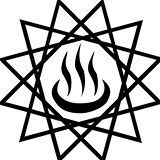Εαρινος Εορτη
Spring Festival
by EagleDragon
Τεμενος τω Απολλων, Διος και Παν
Sanctuary of Apollon, Zeus and Pan
Cranston, Rhode Island
March 19-20, 2005
The festival takes place over three days. The first day is March the 19, and celebrates the return of Persephone to Demeter. After the darkness descends on the first day, a procession takes place to the temenos of Demeter. This is either an actual sanctuary if one is present, or to a place in the home or outdoors, where an altar has been set and a space has been consecrated. On this altar is a statue of Demeter and a space to put a statue or image of Persephone, which for the time being is in a dark place, preferably a basement, cave or underground area. The altar may also be decorated with foliage and strewn with grains if an outdoor space is not available. When all have reached the sanctuary and been purified, the priest, worship-leader, or sacrificer may read a poem about spring to announce the purpose of the festivities. This is then followed by a statement like “I/We are here to celebrate and welcome the coming of Spring!” Following this, Demeter is invoked and asked for Her blessings upon the coming months of planting and harvesting.
Following the invocation, one of the worshippers (if a group is performing this) goes to retrieve the image of Persephone and brings it back to the sanctuary. The image is then placed next to Demeter’s on the altar, symbolizing the return of Persephone from the Underworld and the Mother and Daughter being re-united. Libations and sacrifices are now made in honor of the two Goddesses. Among these sacrifices is a bowl of eggs which have been colored green earlier during the day. These eggs will be later baked into loaves of bread for the Feast of Gaia which happens on the next day. The eggs represent the fertility which is returning to Gaia, represented by the bread. Dancing, feasting, hymn-reading/singing, and meditations can be performed in honor of this date. The night is concluded with personal prayers and a libation of thanks to Demeter and Persephone.
The second day of the festival, March 20, 2005 celebrates the return of fertility to Gaia. The eggs have been baked into spicy bread loaves and brought to the central hearth for a procession. An altar to Gaia is set up either outside with a pit in front of Her image where Her offerings will be placed or an indoor altar with lots of live plants as decorations. A pot of soil is an appropriate offering bowl for an indoor altar.
In the early morning, a sacrifice of water and the dedication of a plant or tree is given to Gaia. A space for a garden (of any kind) which can be laid out around the house and blessed is also a good offering. Next, offerings including seeds, roots, anything to be used in the garden this coming spring are made, given and consecrated. This is followed by a feast in the honor of Gaia’s regained fertility. During the feast, the loaves of bread are passed around to all the participants and eaten. When all of the eggs have been taken out of the loaves, each person goes around and hits their egg against someone else’s, saying “Spring has come!” The one whose egg lasts the longest is considered lucky. This is a variation of a Modern Greek custom which is performed at Greek Easter. This custom supposedly originated on Crete.
On the third day of the festival, March 21, 2005, sacrifices to both Pan and Artemis are made in honor of the animals that are coming out of hibernation. Offerings, blessed by the Gods are left for these animals and the Nymphs to eat as they are welcomed back into the world while the participants say “Come out you tired animals and spirits, for spring is finally here!” Feasting, archery contests, guided meditations, dancing and music making are all great ways of celebrating this day. At nightfall, a closing ceremony is performed where sacrifices, personal prayers and libations can be made as the celebration of Spring comes to a close.
